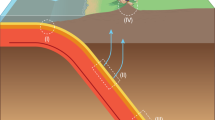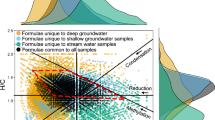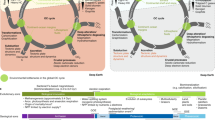Abstract
Science and society are faced with two challenges that are inextricably linked: fossil-fuel energy dependence and rising levels of atmospheric carbon dioxide. Management of remaining hydrocarbon resources, the search for cleaner fuels and increasing interest in subsurface carbon storage all require a better understanding of the deep terrestrial carbon cycle. The coupling of noble gas and carbon chemistry provides an innovative approach to understanding this deep carbon. Whereas carbon geochemistry and isotopic signatures record the history of inorganic and organic reactions that control carbon mobility, the inert noble gases provide unique tracers of fluid origin, transport and age. Together, they have been used to show that groundwater has a key role as both the sink for geologically sequestered carbon dioxide, and in the transport and emplacement of hydrocarbon gas deposits. Furthermore, these tracers have also been used to show that groundwater and subsurface microbiology jointly influence the formation and alteration of fossil-fuel deposits to an extent not previously recognized. The age and distribution of groundwater in fractures in the Earth's crust exert important controls on the Earth's deepest microbial communities.
This is a preview of subscription content, access via your institution
Access options
Subscribe to this journal
Receive 12 print issues and online access
$259.00 per year
only $21.58 per issue
Buy this article
- Purchase on Springer Link
- Instant access to full article PDF
Prices may be subject to local taxes which are calculated during checkout



Similar content being viewed by others
References
Gilfillan, S. M. et al. The noble gas geochemistry of natural CO2 gas reservoirs from the Colorado Plateau and Rocky Mountain provinces, USA. Geochim. Cosmochim. Acta 72, 1174–1198 (2008).
Gilfillan, S. M. et al. Solubility trapping in formation water as dominant CO2 sink in natural gas fields. Nature 458, 614–618 (2009).
Oxburgh, E. R., O'Nions, R. K. & Hill, R. I. Helium isotopes in sedimentary basins. Nature 324, 632–635 (1986).
Marty, B., O'Nions, R. K., Oxburgh, E. R., Martel, D. & Lombardi, S. Helium isotopes in alpine regions. Tectonophysics 206, 71–78 (1992).
Kennedy, B. M. & van Soest, M. C. Flow of mantle fluids through the ductile lower crust: Helium isotope trends. Science 318, 1433–1436 (2007).
Griesshaber, E., O'Nions, R. K. & Oxburgh, E. R. Helium and carbon isotope systematics in crustal fluids from the Eifel, the Rhine Graben and Black Forest, F. R. G. Chem. Geol. 99, 213–235 (1992).
Sherwood Lollar, B., Ballentine, C. J. & O'Nions, R. K. The fate of mantle-derived carbon in a continental sedimentary basin: Integration of C/He relationships and stable isotope signatures. Geochim. Cosmochim. Acta 61, 2295–2307 (1997).
Marty, B. & Tolstikhin, I. N. CO2 fluxes from mid-ocean ridges, arcs and plumes. Chem. Geol. 145, 233–248 (1998).
Ballentine, C. J., Schoell, M., Coleman, D. & Cain, B. A. 300-Myr-old magmatic CO2 in natural gas reservoirs of the west Texas Permian Basin. Nature 409, 327–331 (2001).
de Leeuw, G. A. M., Hilton, D. R., Fischer, T. P. & Walker, J. A. The He-CO2 isotope and relative abundance characteristics of geothermal fluids in El Salvador and Honduras: New constraints on volatile mass balance of the Central American Volcanic Arc. Earth Planet. Sci. Lett. 258, 132–146 (2007).
Toth, J. Cross formational gravity-flow of groundwater: a mechanism of transport and accumulation of petroleum. AAPG Stud. Geol. 10, 121–167 (1980).
Ballentine, C. J., O'Nions, R. K., Oxburgh, E. R., Horvath, F. & Deak, J. Rare gas constraints on hydrocarbon accumulation, crustal degassing and groundwater flow in the Pannonian Basin. Earth Planet. Sci. Lett. 105, 229–246 (1991).
Zartman, R. E., Reynolds, J. H. & Wasserburg, G. J. Helium, argon, and carbon in some natural gases. J. Geophys. Res. 66, 277–306 (1961).
Bosch, A. & Mazor, E. Natural gas association with water and oil as depicted by atmospheric noble gases: case studies from the southeastern Mediterranean Coastal Plain. Earth Planet. Sci. Lett. 87, 338–346 (1988).
Ballentine, C. J. & Sherwood Lollar, B. Regional groundwater focusing of nitrogen and noble gases into the Hugoton-Panhandle giant gas field, USA. Geochim. Cosmochim. Acta 66, 2483–2497 (2002).
Pinti, D. L. & Marty, B. Noble gases in crude oils from the Paris basin, France — Implications for the origin of fluids and constraints on oil-water-gas interactions. Geochim. Cosmochim. Acta 59, 3389–3404 (1995).
Ballentine, C. J., O'Nions, R. K. & Coleman, M. L. A Magnus opus: Helium, neon, and argon isotopes in a North Sea oilfield. Geochim. Cosmochim. Acta 60, 831–849 (1996).
Torgersen, T. & Kennedy, B. M. Air-Xe enrichments in Elk Hills oil field gases: Role of water in migration and storage. Earth Planet. Sci. Lett. 167, 239–253 (1999).
Head, I. M., Jones, D. M. & Larter, A. R. Biological activity in the deep subsurface and the origin of heavy oil. Nature 426, 344–352 (2003).
Jones, D. M. et al. Crude-oil biodegradation via methanogenesis in subsurface petroleum reservoirs. Nature 451, 176–181 (2008).
Zhou, Z. & Ballentine, C. J. He-4 dating of groundwater associated with hydrocarbon reservoirs. Chem. Geol. 226, 309–327 (2006).
Zhou, Z., Ballentine, C. J., Kipfer, R., Schoell, M. & Thibodeaux, S. Noble gas tracing of groundwater/coalbed methane interaction in the San Juan Basin, USA. Geochim. Cosmochim. Acta 69, 5413–5428 (2005).
Torgersen, T. & Clarke, W. B. Helium accumulation in groundwater I. An evaluation of sources and the continental flux of crustal 4He in the Great Artesian Basin, Australia. Geochim. Cosmochim. Acta 49, 1211–1218 (1985).
Wilhelms, A. et al. Biodegradation of oil in uplifted basins prevented by deep-burial sterilization. Nature 411, 1034–1037 (2001).
Jannasch, H. W. The chemosynthetic support of life and the microbial diversity at deep-sea hydrothermal vents. Proc. R. Soc. Lond. B 225, 277–297 (1985).
Shock, E. L. & Schulte, M. D. Organic synthesis during fluid mixing in hydrothermal systems. J.Geophys. Res. 103, 28513–28527 (1998).
Kelley, D. S. et al. A serpentinite-hosted ecosystem: The lost city hydrothermal field. Science 307, 1428–1434 (2005).
Chapelle, F. H. et al. A hydrogen-based subsurface microbial community dominated by methanogens. Nature 415, 312–315 (2002).
Spear, J. R., Walker, J. L., McCollom, T. M. & Pace, N. R. Hydrogen and bioenergetics in the Yellowstone geothermal ecosystem. Proc. Natl Acad. Sci. USA 102, 2555–2560 (2005).
Pedersen, K. Exploration of deep intraterrestrial microbial life: Current perspectives. FEMS Microbiol. Lett. 185, 9–16 (2000).
Lin, L.-H. et al. Long-term sustainability of a high-energy, low-diversity crustal biome. Science 314, 479–482 (2006).
Sherwood Lollar, B. et al. Evidence for bacterially generated hydrocarbon gas in Canadian Shield and Fennoscandian Shield rocks. Geochim. Cosmochim. Acta 57, 5073–5085 (1993).
Lippmann, J. et al. Dating ultra-deep mine waters with noble gases and 36Cl, Witwatersrand Basin, South Africa. Geochim. Cosmochim. Acta 67, 4597–4619 (2003).
Sherwood Lollar, B. et al. Isotopic signatures of CH4 and higher hydrocarbon gases from Precambrian Shield sites: A model for abiogenic polymerization of hydrocarbons. Geochim. Cosmochim. Acta 72, 4778–4795 (2008).
Chivian, D. et al. Environmental genomics reveals a single-species ecosystem deep within Earth. Science 322, 275–278 (2008).
Pedersen, K. & Ekendahl, S. Incorporation of CO2 and introduced organic compounds by bacterial populations in groundwater from the deep crystalline bedrock of the Stripa mine. J. Gen. Microbiol. 138, 369–376 (1992).
Pedersen, K. Microbial life in deep granitic rock. FEMS Microbiol. Rev. 20, 399–414 (1997).
Lin, L. H. et al. Planktonic microbial communities associated with fracture-derived groundwater in a deep gold mine of South Africa. Geomicrobiol. J. 23, 475–497 (2006).
Onstott, T. C. et al. The origin and age of biogeochemical trends in deep fracture water of the Witwatersrand Basin, South Africa. Geomicrobiol. J. 23, 369–414 (2006).
Ward, J. A. et al. Microbial hydrocarbon gases in the Witwatersrand Basin, South Africa: Implications for the deep biosphere. Geochim. Cosmochim. Acta 68, 3239–3250 (2004).
Ballentine, C. J., Burgess, R. & Marty, B. Tracing fluid origin, transport and interaction in the crust. Rev. Mineral. Geochem. 47, 539–614 (2002).
Andrews, J. N. The isotopic composition of radiogenic helium and its use to study groundwater movement in confined aquifers. Chem. Geol. 49, 339–351 (1985).
Kipfer, R., Aeschbach-Hertig, W., Peeters, F. & Stute, M. Noble gases in lakes and ground waters. Rev. Mineral. Geochem. 47, 615–700 (2002).
Andrews, J. N. & Lee, D. J. Inert gases in groundwater from the Bunter Sandstone of England as indicators of age and paleoclimatic trends. J. Hydrol. 41, 233–252 (1979).
Heaton, T. H. E. & Vogel, J. C. 'Excess air' in groundwater. J. Hydrol. 50, 201–216 (1981).
Stute, M., Schlosser, P., Clark, J. F. & Broecker, W. S. Paleotemperatures in the southwestern United States derived from noble gases in ground water. Science 256, 1000–1003 (1992).
Ballentine, C. J. & Hall, C. M. Determining paleotemperature and other variables by using an error-weighted, nonlinear inversion of noble gas concentrations in water. Geochim. Cosmochim. Acta 63, 2315–2336 (1999).
Aeschbach-Hertig, W., Peeters, F., Beyerle, U. & Kipfer, R. Interpretation of dissolved atmospheric noble gases in natural waters. Wat. Resour. Res. 35, 2779–2792 (1999).
Acknowledgements
We express our thanks to all the many colleagues and co-workers whose scientific research and insightful advances in the use of noble gas geochemistry and carbon geochemistry informed the developments highlighted in this article.
Author information
Authors and Affiliations
Contributions
B.S.L. and C.J.B. jointly conceived and wrote the paper.
Corresponding authors
Rights and permissions
About this article
Cite this article
Lollar, B., Ballentine, C. Insights into deep carbon derived from noble gases. Nature Geosci 2, 543–547 (2009). https://doi.org/10.1038/ngeo588
Published:
Issue Date:
DOI: https://doi.org/10.1038/ngeo588
This article is cited by
-
Fluid geochemistry of the Mondragone hydrothermal systems (southern Italy): water and gas compositions vs. geostructural setting
International Journal of Earth Sciences (2017)



